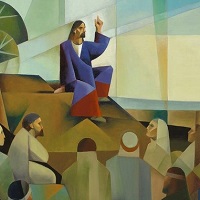
Matthew’s Gospel offers a distinctive Jewish dimension, reflecting the Palestine of the late first century of the Common Era (70 CE (AD)). The writer was probably a Palestinian. To create his Gospel, this late first-century evangelist used Mark’s Gospel, a source called Q (Quelle in German), and a collection of sayings as the main sources.
The Gospel comes to life after the temple’s destruction in AD 70. It reflects the inner turmoil and infighting within rabbinical Judaism as they face the future without a temple. Matthew offers his solution as a follower of The Way (later a Christian).
Matthew’s Gospel is one Jewish response to the destruction of the temple and the experience of the diaspora. In this situation of extraordinary loss, the continuity of tradition between the Torah, Moses and Jesus is utterly critical. To emphasise this continuity, key parts will end with the phrase: “all this took place to fulfil the words spoken by the prophet…” Perhaps we’d describe this as living the Torah in difficult times or responding in faith too difficult times.
Written for a largely Jewish (Christian) community, the Gospel situates the communities of Jesus of Nazareth within the Jewish tradition and legitimates their vision for Judaism. It does this most consistently by appealing to the Hebrew Testament. These are the proof texts that underpin the validity of the Gospel.
The Gospel is set in five large blocks of speeches (chapters 5-7, 10, 13, 18, 24-25), each ending with the phrase “when Jesus finished these words”, referring to something having happened or having been taught. The proclamation of Emmanuel begins the Gospel, and the promise of Emmanuel ends it. Throughout, there is an alternating pattern of narrative and discourse:
- Who and where of Jesus (1:1-2; 23)
- The beginning of Jesus’ activity (3:1-4;25)
- The Sermon on the Mount (5:1-7;29)
- The missionary discourse (10: 1-42)
- The rejection of Jesus (11:1-12;50)
- Parables of the kingdom (13:1-53)
- Miracles, controversies and the cross (13:54-17;27)
- Advice to a divided community (18:1-35)
- Opposition to Jesus (19:1-23; 39)
- The coming of the kingdom (24:1-25;46)
- Jesus’ death and resurrection (26:1-28;20)
Theology
Theologically it locates Jesus within the Jewish tradition and names him using ancient titles, of which the most important is the Son of God. Occasionally the Greek title Kyrios is used as a flash of divinity. This is evidence of a growing Greek influence in scriptural and theological thinking.
Some suggest that Matthew’s Gospel has an anti-Semitic tone. I would argue against this, given what anti-Semitism means today. The Scribes and Pharisees (founders of modern Judaism) are caricatured and criticized because of their legalistic approach to religious practice. Matthew’s main complaint against them is that they narrow the universal gift of God to all people and turn religious practice into a badge of “authentic Jewishness”. This criticism is better read as part of the infighting within rabbinical Judaism at that time.
A good example of this is Chapter 21:41. The Kingdom given to the Jewish nation (other rabbinic schools) will be taken from them and given to the new Matthean community (21:41): “will put those wretches (the leaders) to a miserable death and let out the vineyard (Israel) to other tenants (Christians) who will give him (God) the fruits in their season.”
Matthew is more generous to the disciples than Mark! Matthew’s disciples are the companions of Jesus and serve as the model for Matthean Christians. Although they understand Jesus in limited ways their “little faith” (6:30), though it fails, is still real. The disciples share in the power of the risen Lord and faithfully transmit the teachings of Jesus.
Finally, what marks Matthew’s Gospel as significant is the way it presents Jesus’ teaching is authoritative. Jesus’ teaching is authoritative because it interprets the Torah, thus, Jesus’ teaching is the criterion for judging the Torah, not the other way around!
Joe Grayland


